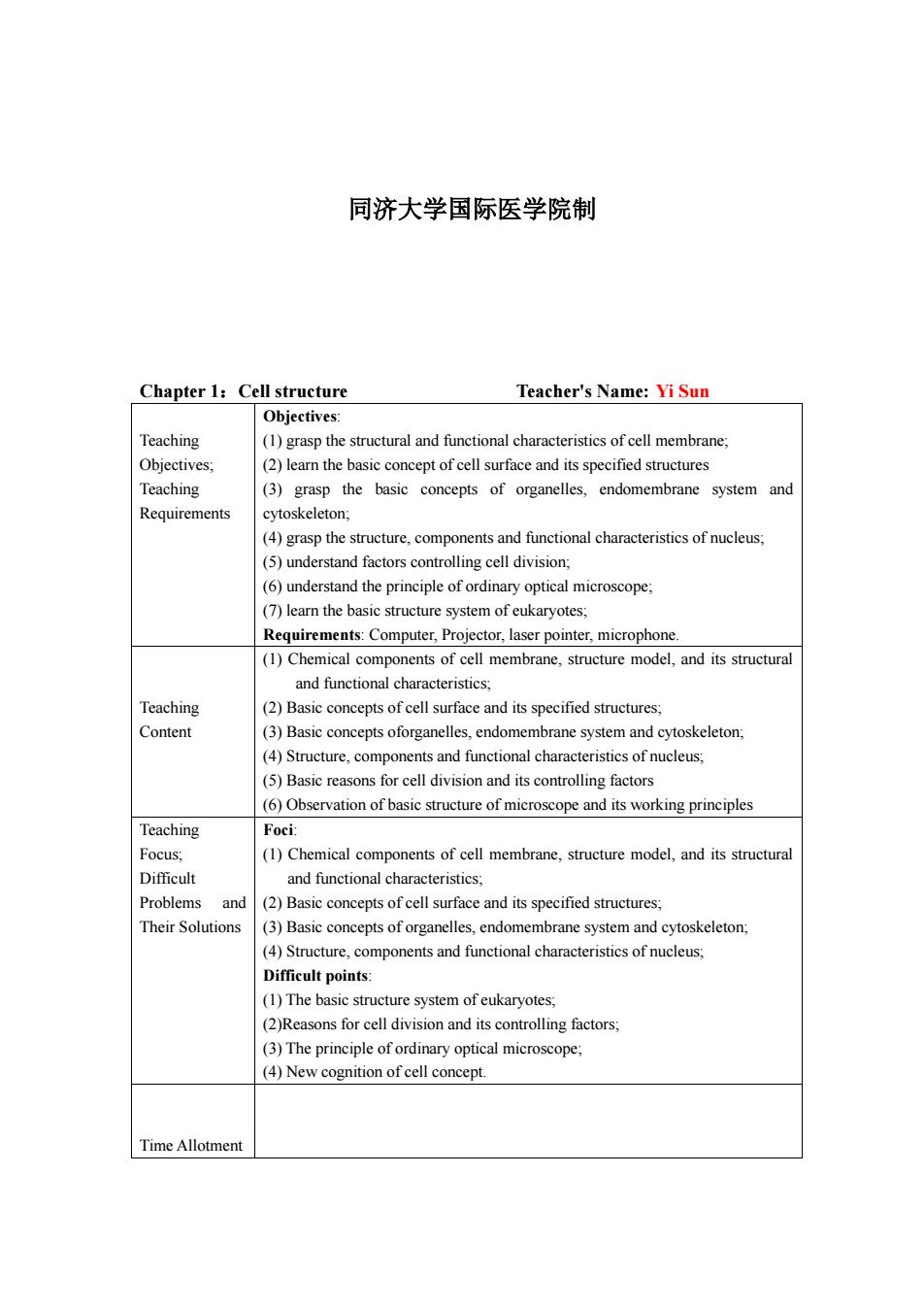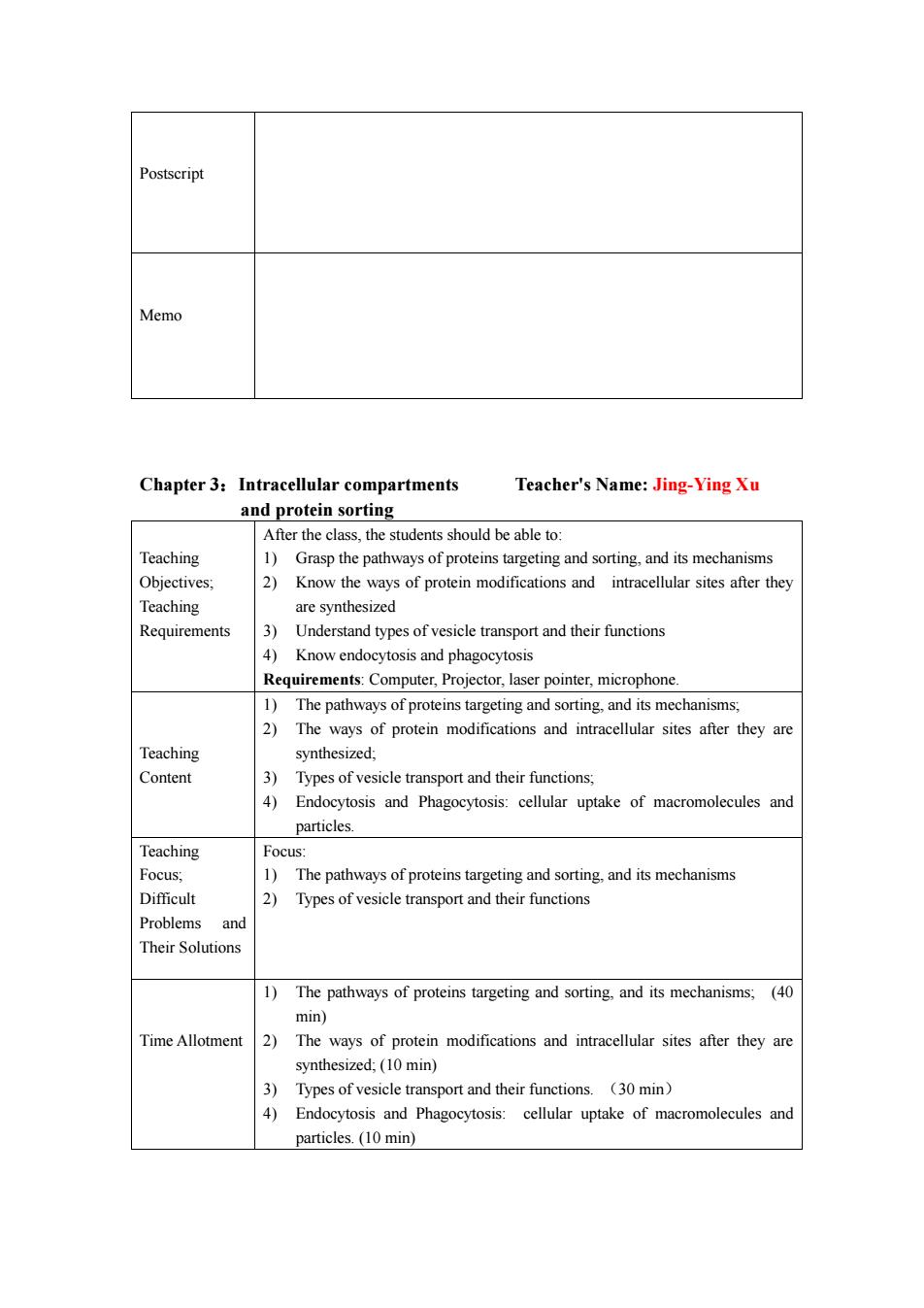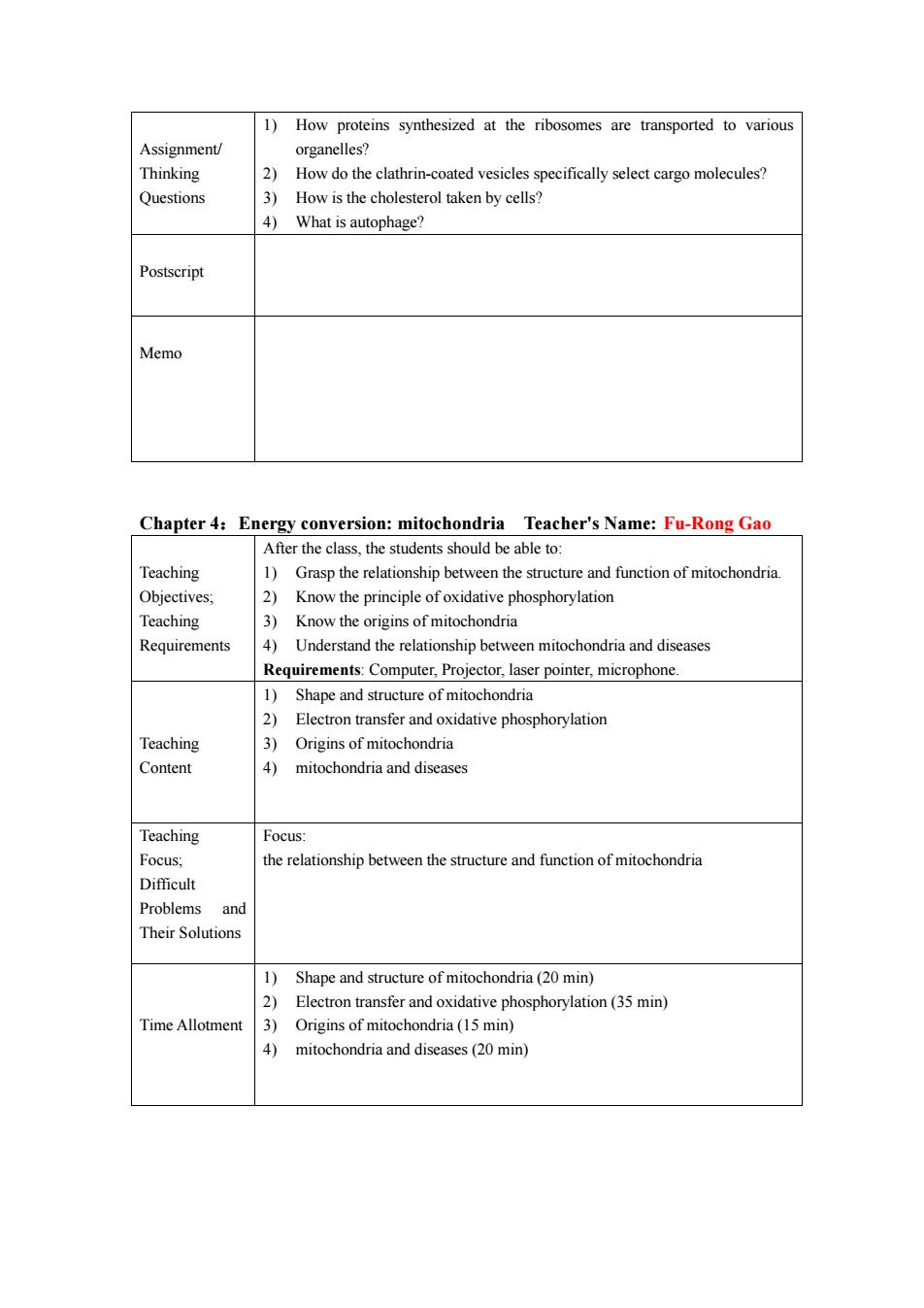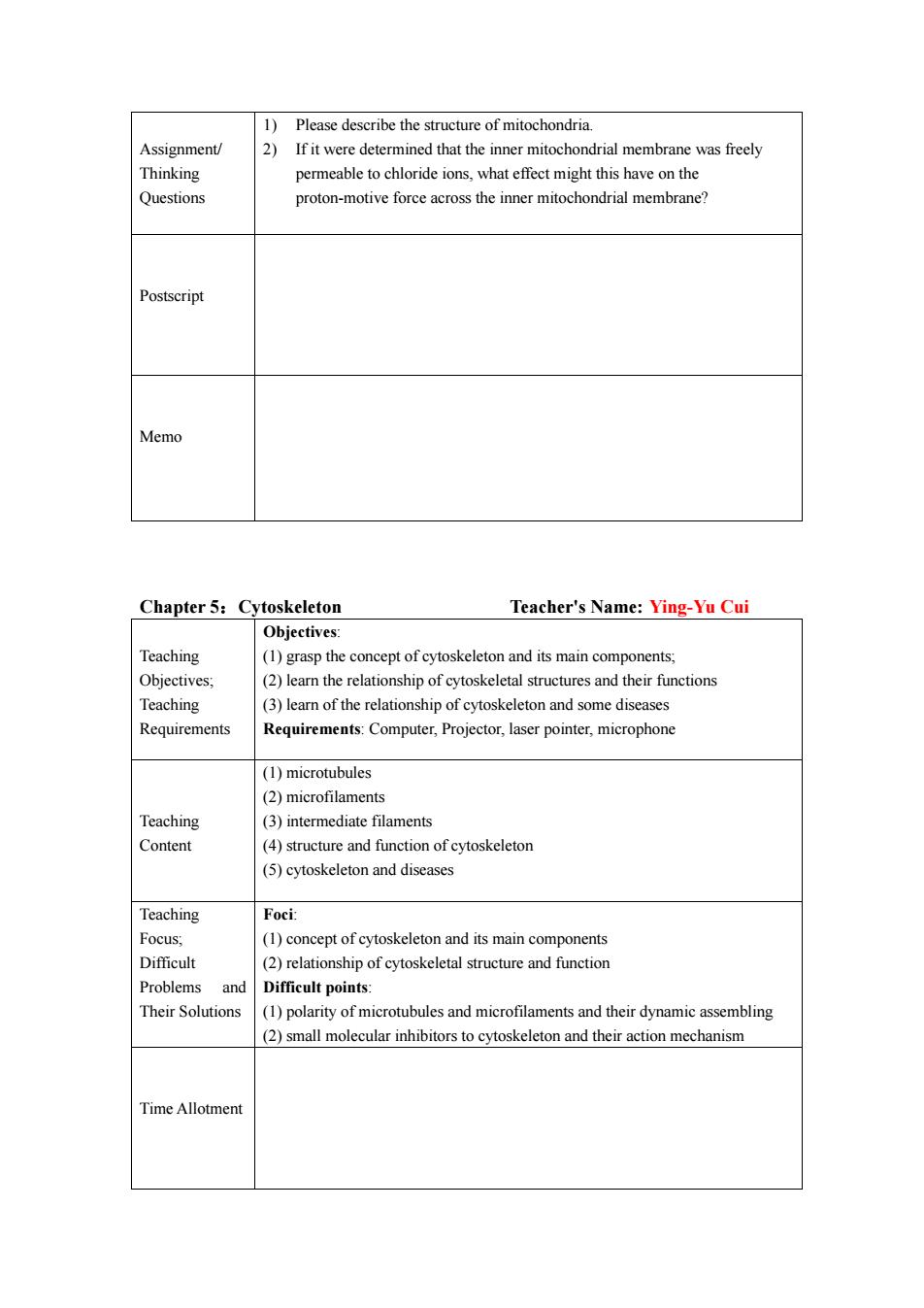
同济大学国际医学院制 Chapter 1:Cell structure Teacher's Name:Yi Sun Objectives Teaching (1)grasp the structural and functional characteristics of cell membrane. Objectives, (2)learn the basic concept of cell surface and its specified structures Teaching (3)grasp the basic concepts of organelles,endomembrane system and Requirements cytoskeleton: (6)understand the principle of ordinary optical microscope, (7)learn the basic structure system of eukaryotes; Requirements:Computer,Projector,laser pointer,microphone. (1)Chemical comp ents of cell membrane.structure model,and its structural andftnctionalcharactersticy Teaching (2)Basic concepts of cell surface and its specified structures Content (3)Basic concepts oforganelles,endomembrane system and cytoskeleton. (4)Structure,components and functional characteristics of nucleus. (5)Basic reasons for cell division and its controlling factors 6)Observation of basic of microscope and its orking principles Teaching Foci: Focus: (1)Chemical components of cell membrane,structure model,and its structural Difficult and functional characteristics Problems and (2)Basic concepts of cell surface and its specified structures Their Solutions ()Basic concepts of organelles.endomer rane system and cytoskeleton (4)Structure,components and functional characteristics of nucleus; Difficult points: (1)The basic structure system of eukaryotes: (2)Reasons for cell division and factors (4)New cognition of cell concept. Time Allotment
同济大学国际医学院制 Chapter 1:Cell structure Teacher's Name: Yi Sun Teaching Objectives; Teaching Requirements Objectives: (1) grasp the structural and functional characteristics of cell membrane; (2) learn the basic concept of cell surface and its specified structures (3) grasp the basic concepts of organelles, endomembrane system and cytoskeleton; (4) grasp the structure, components and functional characteristics of nucleus; (5) understand factors controlling cell division; (6) understand the principle of ordinary optical microscope; (7) learn the basic structure system of eukaryotes; Requirements: Computer, Projector, laser pointer, microphone. Teaching Content (1) Chemical components of cell membrane, structure model, and its structural and functional characteristics; (2) Basic concepts of cell surface and its specified structures; (3) Basic concepts oforganelles, endomembrane system and cytoskeleton; (4) Structure, components and functional characteristics of nucleus; (5) Basic reasons for cell division and its controlling factors (6) Observation of basic structure of microscope and its working principles Teaching Focus; Difficult Problems and Their Solutions Foci: (1) Chemical components of cell membrane, structure model, and its structural and functional characteristics; (2) Basic concepts of cell surface and its specified structures; (3) Basic concepts of organelles, endomembrane system and cytoskeleton; (4) Structure, components and functional characteristics of nucleus; Difficult points: (1) The basic structure system of eukaryotes; (2)Reasons for cell division and its controlling factors; (3) The principle of ordinary optical microscope; (4) New cognition of cell concept. Time Allotment

(1)Talk about the components of cell surface and their respective significance. Assignment/ (2)Talk about your own cognition about basic structure system of eukaryoti Thinking Questions (3)Why can a cell divide into two?What are the limiting factors? (4)Talk about your own cognition of cell concept. Postscript Memo Chapter 2:Cell membrane and cell junction Teacher's Name:Fu-Rong Gao After the class,the students should be able to: 1Understand the chemical composition and characteristics of membranes Objectives, Grasp the types of membrane transport and their differenes Teaching 3)Grasp the types of cell junction and their function Requirements 4)Know the adhesion molecules and extracellular matrix Requirements:Computer,Projector,laser pointer,microphone. 1)The chemical composition of membranes Teaching 3)Passive transport and active transport Content 4)Cell junction,adhesion molecules and extracellular matrix Teaching Focus Focus 1)Chemical composition and characteristics of membranes Passive ranspor and active transpor Problems and 3) Types of cell junction and their function Their Solutions 1)The chemical composition of membranes(20 min) 2)Characteristics of biomembrane(5min) Time Allotment 3)Passive transport and active transport(40 min) 1)What are the three main types of lipid molecules found in biomembranes Assignment/ 2)How are the three types similar and how are they different Thinking 3)How does active transport differ from facilitated diffusion? Questions 4)What is the function of a gap junction?
Assignment/ Thinking Questions (1)Talk about the components of cell surface and their respective significance. (2) Talk about your own cognition about basic structure system of eukaryotic cell. (3) Why can a cell divide into two? What are the limiting factors? (4) Talk about your own cognition of cell concept. Postscript Memo Chapter 2:Cell membrane and cell junction Teacher's Name: Fu-Rong Gao Teaching Objectives; Teaching Requirements After the class, the students should be able to: 1) Understand the chemical composition and characteristics of membranes 2) Grasp the types of membrane transport and their differences 3) Grasp the types of cell junction and their function 4) Know the adhesion molecules and extracellular matrix Requirements: Computer, Projector, laser pointer, microphone. Teaching Content 1) The chemical composition of membranes 2) Characteristics of biomembrane 3) Passive transport and active transport 4) Cell junction, adhesion molecules and extracellular matrix Teaching Focus; Difficult Problems and Their Solutions Focus: 1) Chemical composition and characteristics of membranes 2) Passive transport and active transport 3) Types of cell junction and their function Time Allotment 1) The chemical composition of membranes (20 min) 2) Characteristics of biomembrane (5min) 3) Passive transport and active transport (40 min) 4) Cell junction, adhesion molecules and extracellular matrix (25 min) Assignment/ Thinking Questions 1) What are the three main types of lipid molecules found in biomembranes? 2) How are the three types similar and how are they different? 3) How does active transport differ from facilitated diffusion? 4) What is the function of a gap junction?

Memo Chapter 3:Intracellular compartments Teacher's Name:Jing-Ying Xu and protein sorting After the class,the students should be able to: Teaching 1)Grasp the pathways of proteins targeting and sorting,and its mechanisms Objectives Know the ations and intracellular sites after the Teaching Requirements 3)Understand types of vesicle transport and their functions 4)Know endocytosis and phagocytosis Requirements:Computer.Proiector.laser pointer.microphone The pathways of proteins targetingand it s me The ways of protein modifications and intracellular sites after they are Teaching synthesized: Content 3)Types of vesicle transport and their functions; 4)Endocytosis and Phagocytosis:cellular uptake of macromolecules and Teaching Focus: Focus; 1)The pathways of proteins targeting and sorting,and its mechanisms Difficult 2)Types of vesicle transport and their functions Problems and Their Solutions The pathways of proteins targeting and sorting.and its mechanisms:(40 min) Time Allotment 2) The ways of protein modifications and intracellular sites after they are synthesized,(10min) 3)Types of vesicle transport and their functions.(30 min) Endocytosis and Phagocytosis particles.(10min)
Postscript Memo Chapter 3:Intracellular compartments Teacher's Name: Jing-Ying Xu and protein sorting Teaching Objectives; Teaching Requirements After the class, the students should be able to: 1) Grasp the pathways of proteins targeting and sorting, and its mechanisms 2) Know the ways of protein modifications and intracellular sites after they are synthesized 3) Understand types of vesicle transport and their functions 4) Know endocytosis and phagocytosis Requirements: Computer, Projector, laser pointer, microphone. Teaching Content 1) The pathways of proteins targeting and sorting, and its mechanisms; 2) The ways of protein modifications and intracellular sites after they are synthesized; 3) Types of vesicle transport and their functions; 4) Endocytosis and Phagocytosis: cellular uptake of macromolecules and particles. Teaching Focus; Difficult Problems and Their Solutions Focus: 1) The pathways of proteins targeting and sorting, and its mechanisms 2) Types of vesicle transport and their functions Time Allotment 1) The pathways of proteins targeting and sorting, and its mechanisms; (40 min) 2) The ways of protein modifications and intracellular sites after they are synthesized; (10 min) 3) Types of vesicle transport and their functions. (30 min) 4) Endocytosis and Phagocytosis: cellular uptake of macromolecules and particles. (10 min)

1)How proteins synthesized at the ribosomes are transported to various Assignment/ Thinking 2) sspecifically select cargo molecules? Questions 3)How is the cholesterol taken by cells? 4)What is autophage? Postscript Memo Chapter 4:Energy conversion:mitochondria Teacher's Name:Fu-Rong Gao After the class,the students should be able to: Teaching Grasp the relationship between the structure and function of Objectives; Know the principle of oxidative phosphorylation Teaching 3)Know the origins of mitochondria Requirements 4)Understand the relationship between mitochondria and diseases Requirements:Computer,Projector,laser pointer,microphone. Shapeand structure of 2) Electron transfer and oxidative phosphorylation Teaching 3)Origins of mitochondria Content 4)mitochondria and diseases Teaching Focus: Focus relationship bet ween the structure and function of mitochondria Problems and Their Solutions 1)Shape and structure of mitochondria(20 min) 2)Electron transfer and oxidative phosphorylation(35 min) Time Allotment3)Origins of mitochondria (15 min) 4) ochondria and diseases(20min)
Assignment/ Thinking Questions 1) How proteins synthesized at the ribosomes are transported to various organelles? 2) How do the clathrin-coated vesicles specifically select cargo molecules? 3) How is the cholesterol taken by cells? 4) What is autophage? Postscript Memo Chapter 4:Energy conversion: mitochondria Teacher's Name: Fu-Rong Gao Teaching Objectives; Teaching Requirements After the class, the students should be able to: 1) Grasp the relationship between the structure and function of mitochondria. 2) Know the principle of oxidative phosphorylation 3) Know the origins of mitochondria 4) Understand the relationship between mitochondria and diseases Requirements: Computer, Projector, laser pointer, microphone. Teaching Content 1) Shape and structure of mitochondria 2) Electron transfer and oxidative phosphorylation 3) Origins of mitochondria 4) mitochondria and diseases Teaching Focus; Difficult Problems and Their Solutions Focus: the relationship between the structure and function of mitochondria Time Allotment 1) Shape and structure of mitochondria (20 min) 2) Electron transfer and oxidative phosphorylation (35 min) 3) Origins of mitochondria (15 min) 4) mitochondria and diseases (20 min)

1)Please describe the structure of mitochondria Assignment Thinking permeable to chloride ions,what effect might this haveon the Questions proton-motive force across the inner mitochondrial membrane? Postscript Memo Chapter 5:Cytoskeleton Teacher's Name:Ying-Yu Cui Objectives: Teaching (1)grasp the concept of cytoskeleton and its main components: Obiectives (2)learn the relationship of cytoskeletal structures and their functions Teaching Requirements Requirements:Computer,Projector,laser pointer,microphone (1)microtubules (2)microfilaments Teaching (3)intermediate filaments Content (4)structure and function of cytoskeleton (5)cytoskeleton and diseases Teaching Foci Focus, (1)concept of eytoskeleton and its main components Difficult (2)relationship of cytoskeletal structure and function Problems and Difficult points: Their Solutions (1)polarity of microtubules and microfilaments and their dynamic assembling (2)small molecular inhbitors to cytoskeleton and their action mechanism Time Allotment
Assignment/ Thinking Questions 1) Please describe the structure of mitochondria. 2) If it were determined that the inner mitochondrial membrane was freely permeable to chloride ions, what effect might this have on the proton-motive force across the inner mitochondrial membrane? Postscript Memo Chapter 5:Cytoskeleton Teacher's Name: Ying-Yu Cui Teaching Objectives; Teaching Requirements Objectives: (1) grasp the concept of cytoskeleton and its main components; (2) learn the relationship of cytoskeletal structures and their functions (3) learn of the relationship of cytoskeleton and some diseases Requirements: Computer, Projector, laser pointer, microphone Teaching Content (1) microtubules (2) microfilaments (3) intermediate filaments (4) structure and function of cytoskeleton (5) cytoskeleton and diseases Teaching Focus; Difficult Problems and Their Solutions Foci: (1) concept of cytoskeleton and its main components (2) relationship of cytoskeletal structure and function Difficult points: (1) polarity of microtubules and microfilaments and their dynamic assembling (2) small molecular inhibitors to cytoskeleton and their action mechanism Time Allotment